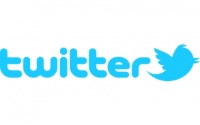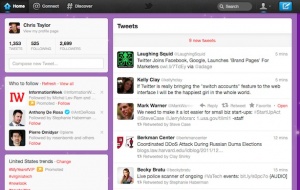Difference between revisions of "Twitter"
| Line 77: | Line 77: | ||
[[Category:Social Networking]] | [[Category:Social Networking]] | ||
[[Category:Websites]] | [[Category:Websites]] | ||
| − | [[Category: | + | [[Category:Services]] |
Revision as of 21:51, 13 December 2011
Twitter is a free online microblogging service that allows users to post and share statuses or updates in 140 characters or less. These updates are known as "tweets". Users can follow the accounts of other users, and other users can follow them. Following on Twitter doesn't have to be mutual, unlike being friends on Facebook. Twitter is often used by celebrities so their fans can follow them and offers a 'verified' ability where celebrities can prove who they are to Twitter and their fans. This helps eliminate fake pages and ensures validity for fans. The most common topic on Twitter is technology. The speed of news has become exponentially faster through the use of Twitter. You no longer need to wait for a news article to be written about breaking news, a single tweet can inform the public about the news. A prime example is the news of Osama bin Ladin's death being first released on Twitter.
Contents
History
The founders of Twitter were Jack Dorsey, Noah Glass, Evan WIlliams and Biz Stone. Jack Dorsey launched Twitter on July 15th, 2006 where it rapidly gained users worldwide. Currently, it has over 380 millions accounts and generates over 300 million tweets per day. People often refer to Twitter as "the SMS of the Internet". [1]
The company that operates Twitter (Twitter Inc. is based in San Francisco. The word "twitter" was a perfect name for the site according to Dorsey. He explains that its definition is 'a short bust of inconsequential information' and 'chirps from birds'. [2] This refers to the 140 character limit.
Dorsey remained the chief executive officer of Twitter until October 16, 2008 when Evan Williams took over the CEO role, and Dorsey became chairman of the board. Williams stepped down as CEO 2 years later, in 2010, and Twitter's chief operating officer (COO), Dick Costolo became the new (and current) CEO. Dorsey remains an executive chairman to this day. [3]
After Costolo took over, Twitter started to gain significantly more users. Twitter went from 400,000 tweets posted per quarter in 2007, to 100 million tweets posted per quarter in 2008, and by March 2010, users were sending 50 million tweets per day. [4]
The Twitter interface remained the same through much of this growth, but in late 2010, the company began rolling out a revamped Twitter. The new site now had the ability to see pictures and videos without leaving Twitter itself by supporting websites including YouTube and Flickr. These are generally hosted on twitpic.com. In December 2011, Twitter had launched a major redesigned to create a more efficient and accessible user interface to a attract new users. The design includes four labels on top of the site: home, connect, discover, and the user. The user's profile and trending topics are on the left, while the tweets are on the right side. The new design is to compete with Facebook's new timeline interface to create a more timeless experience for the user.
Twitter is currently located at 795 Folsom St. ste 600, San Francisco CA 94107. In 2010 they had $140 million in revenue and over 600 employees. They are currently ranked 9th on Alexa and supports many languages. [5] In December 2011, Twitter announced that it will move into their new headquarters on June 2012. The new headquarters will be moved from the Folsom St. to the Market Square building on 1355 Market St. in San Francisco, CA. The company has plans to increase its workforce to about 3,000 by 2013.[6]
Common Terminology
- Direct Message: A direct message, commonly referred to as simply a message, is a private message sent between two users.
- Favorite: A tweet that has been marked with a star.
- Follow: To follow someone means you are subscribing to receive their tweets.
- Follower: A follower is another user who follows you.
- Handle: A handle is simply a username.
- Hashtag: A hashtag is the "#" symbol and is used to indicate trending topics or specific words in a tweet. Links tweets when using the same hashtag.
- Lists: A custom group where a user can filter their news feed into smaller groups based on their grouping.
- Mention: To mention another user means to include the "@" symbol followed by their Twitter handle in the tweet.
- News Feed: A chronological list of tweets composed of the people a user follows.
- Profile: The public appearance of a user's tweets with a customizable backgrounds and profile pictures.
- Reply: A user can respond to a tweet sent by someone they follow, however the response can only be seen by the original sender if they follow them or their tweets are unprotected
- Retweet: A tweet that has been tweeted again by a different user. Signified by RT.
- Trending Topic: A popular subject being talked about on Twitter, indicated by a hashtag and calculated algorithmically. Can specify your location to see what is trending in your country or city
- Tweet: A message posted on Twitter contained 140 characters or less. Tweet is also a verb referring to the act of sending a message on Twitter.
Features
Twitter encourages you to "follow your interests." [7] It is common to follow your friends, industry experts, and celebrities. Once an account is set up, users' tweets are publicly visible by default. However, there is a setting that allows people to restrict their viewers by privatizing their account. People can "tweet" from a computer on the website, from smartphones, tablets, or other mobile devices, or via text message (SMS). Applications have been developed by Twitter itself for Apple computers, Apple iOS devices, Android devices, and Blackberry devices. Other third party applications, such as UberSocial or HootSuite have also been developed to aid in the tweeting process.
Tweets
Not only can you tweet whatever you want, you can also reply to others tweets simply by mentioning the other user in your tweet. Mentioning someone can be done by using the "@" sign followed by their Twitter username. Users have the ability to mention more than one user in a tweet, too.
"Retweeting" is common on Twitter as well. If users want to copy someone's tweet so that one's own followers see it, they can do so by retweeting it and either adding text to the retweet (if you have enough characters left) or simply retweet it with no additions.
To help with the small character limit in tweets, there are tons of URL shortening services that are commonly used. Some include: bit.ly, Twitpic, and Twitter has it's own t.co domain that shortens all URLs posted on the site. Users are also able to tweet photos and videos via these link shortening services.
Trending Topics
One of Twitter's main features is the trending topics feature on the right sidebar of the site. Users will group together topics by the use of "hashtags." Hashtags are words or phrases starting with the "#" sign. Users may view what topics are trending in certain cities or what is trending worldwide. Trending topics become popular through word of mouth and are the way that people often first learn of breaking news.
Aside from the general trending topics, there are also promoted topics. In these promoted topics, companies can pay a fee to have their topic appear at the top of the list with the other trending topics that people look for.
Direct Messages
Other than tweeting, users have the ability to direct message or "DM" other users. Direct messages are privately sent messages that only the people you send it to can see. The only way two users can direct message each other is if they are both following each other.
Verified Accounts
Verified accounts were introduced on Twitter in order to create revenue as well as to protect corporations and celebrities from fake Twitter sites distributing inaccurate information to followers. These verified accounts are obtained through payment to Twitter. A verified account is displayed by a blue and white check symbol following the username of the individual of corporation. This is Twitter's way of confirming that the individual or corporation is who they claim to be.
New Twitter
Twitter recently released a formatting update, renaming several of the features and creating an activity log. Twitter selects a few top stories, videos or topics under the "Discover" page and connects news articles or YouTube videos with tweets about that topic. They also released the "Connect" page that shows new followers, mentions and retweets.
Celebrities and Twitter
Twitter does not require mutuality in order to see user's tweets. Because of this feature users feel closer to their idols where as other Social Networking sites do not have this tool. The prominence of celebrities on Twitter is demonstrated when Lady Gaga, Justin Bieber and Britney Spears all have more followers than the population of Sweden, Greece and Israel. Ashton Kutcher was the first twitter user to get 1,000,000 followers. He challenged CNN to see who would get to a million followers first, him or the breaking news twitter feed,Kutcher Won.This was an attribute to changing ways Twitter could be used, and an insight into who Americans are paying attention to. Justin Bieber actively tweets. His fans also actively tweet at and about him, and 3.0% of all Twitter activity at any time is associated to Bieber and he has racks of servers solely devoted to him [8]. When he stops tweeting for periods of time, his fans begin to believe that he has died. It late 2010, some celebrities did just this and "died" on twitter to raise money for the Keep a Child Alive Campaign.The Kardashian Sisters, Lady Gaga, Alicia Keys, Justin Timberlake and others all stopped going on twitter until a 1 million USD was raised for the charity[9]. The effects that celebrities can have via twitter are both beneficial and mundane.
Ethical Implications/Privacy Concerns
As with other social media technologies, Twitter has been targeted as an example of how technology is reducing the quality of human interaction and language in society. Twitter, in particular, relies on fast-paced updates and abbreviations in order to meet the 140 character limitation. Because of this environment, more interesting forms of spelling and slang has been developed through this concise interaction. Many English teachers have bemoaned the apparent deteriorating state of the vernacular.
Privacy, specifically Privacy in Social Networking, is another issue that arises with Twitter. When an account is set to private, other users cannot retweet a private user's tweets, however there is always the option to copy and paste a certain text or passage into a new tweet. In this way, the tweet will not show as one of your own tweets retweeted, but rather as a separate tweet from the second user. Either way, once the information is out to the world, it cannot be withdrawn. So, in essence, an account is never fully privatized. Especially high profile people like celebrities, their tweets are under a microscope. People are in essence creating a brand name for themselves. Who they follow, what the retweet, and what they tweet is how their reputation is made. It's not about who they actually are or their intentions, it's how Twitter makes them come across to the world. Is all of this ethical? It is ethical to not be able to fully keep anything on Twitter private?
In April 2010, Twitter and the United States Library of Congress announced a partnership in which every public tweet since Twitter's inception in 2006 will be digitally archived. [10]
References
- ↑ http://en.wikipedia.org/wiki/Twitter#cite_note-9
- ↑ http://latimesblogs.latimes.com/technology/2009/02/twitter-creator.html
- ↑ http://en.wikipedia.org/wiki/Twitter
- ↑ http://en.wikipedia.org/wiki/Twitter#cite_note-9
- ↑ http://en.wikipedia.org/wiki/Twitter
- ↑ http://articles.sfgate.com/2011-04-23/business/30226870_1_tenderloin-areas-twitter-and-other-companies-central-market
- ↑ http://www.twitter.com
- ↑ http://gizmodo.com/5632095/justin-bieber-has-dedicated-servers-at-twitter
- ↑ http://www.huffingtonpost.com/2010/11/28/lady-gaga-alicia-keys-to-_n_788864.html
- ↑ http://www.loc.gov/today/pr/2010/10-081.html
http://support.twitter.com/articles/166337-the-twitter-glossary

